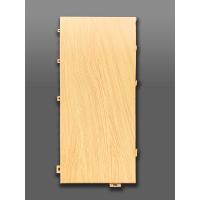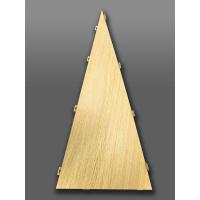Aluminum veneer:
Wood-grain aluminum veneer is a high-grade metal decorative
material mainly made of high-grade aluminum alloy materials. It is
formed by technologies such as CNC bending, and Italian wood-grain
film is adopted based on its surface fluorocarbon spraying. After
the vacuum treatment, the wood-grain film is transferred to the
fluorocarbon coating of the aluminum veneer.
- Exquisite Aesthetic Appeal: Employing globally advanced new-pattern decorative materials, it
showcases high-end and magnificent patterns. The texture is
lifelike, the color is vivid, and the patterns are durable and
wear-resistant. Free from harmful gases like formaldehyde, it is
non-toxic and environmentally friendly. This means there's no need
to worry about the pungent odors from paints and adhesives after
decoration and the potential harm they pose to health.
- Lightweight yet High - Strength: Characterized by its lightweight, excellent rigidity, and high
strength, a 3.0 mm-thick aluminum plate weighs only 8kg per square
meter, with a tensile strength ranging from 100 to 280N/mm².
- Superior Weather and Corrosion Resistance: Utilizing PVDF fluorocarbon paint based on Kynar - 500 and
Hylur500, the surface of the aluminum veneer remains color-fast for
50 years. It can effectively withstand the erosion of acid rain,
air pollution, and ultraviolet light.
- Outstanding Processability: Through the process of pre-processing followed by painting, the
aluminum plate can be shaped into various complex geometric forms
such as flat surfaces, arcs, and spheres, satisfying the demands of
diverse architectural designs.
- Uniform Coating and Diverse Color Options: Thanks to advanced electrostatic spraying technology, the paint
adheres evenly to the aluminum plate. There is a wide range of
colors available, providing ample choices to meet the color
requirements of modern buildings.
- Stain-Resistant and Easy to Clean and Maintain: Due to the non-stick nature of the fluorine-coated film,
pollutants have difficulty adhering to the surface. It has
excellent self-cleaning properties and remarkable anti-fouling
performance. Even if it gets soiled, cleaning is extremely
convenient and labor-saving.
- Convenient and Rapid Installation and Construction: The aluminum plate is prefabricated in the factory, eliminating
the need for on-site cutting. It can be directly fixed onto the
skeleton, significantly shortening the construction period and
enhancing construction efficiency.
- Recyclable and Environmentally Conscious: The aluminum plate is 100% recyclable. Unlike decorative
materials like glass, stone, and ceramics. it has a high recycling
value, meeting the sustainable development requirements of modern
society.
- Good Fire Resistance: With a certain thickness and made of aluminum alloy, it is not
easily ignited or burned. Applying a fireproof coating on the
surface can further enhance its fire-resistance performance.
- High Plasticity: It can be processed into various intricate shapes, and materials
for thermal insulation, sound insulation, and sound absorption can
be filled on its back, enriching its functions. For instance, it
can be customized according to customer's specific needs to meet
different architectural design demands.

BTW : The aluminum prices are fluctuating, so are costs.
Aluminum veneer Needs Design Drawings
1.Floor Plan
The floor plan should cover the overall layout of the building, the
functional division of each room, and the location and dimensions
of doors and windows. As aluminum veneer may be applied to the
building facade, interior partitions, etc., the floor plan can
assist the supplier in understanding the specific location and
surrounding environment of the aluminum veneer, to determine its
layout and installation method.
2.Layout Drawing
The layout drawing should clarify the arrangement of aluminum
veneer on the wall, the division of plates, dimensions, and
quantity. The layout drawing should be drawn according to the
architectural design requirements and the actual wall conditions,
taking into account the processing technology and installation
sequence of the aluminum veneer, minimizing the splicing joints,
and improving the overall aesthetics.

3. Processing Drawing & Node Drawing
The processing drawing needs to mark the specific processing
dimensions, shapes, folding positions, and angles, opening
positions and dimensions, and other processing details of the
aluminum veneer. For aluminum veneers with special shapes or
process requirements, such as curved or special-shaped aluminum
veneers, the processing drawing should provide accurate curve data
and processing process requirements to enable the supplier to carry
out accurate processing and production.

Other Relevant Drawings
Electrical and Equipment Layout Drawing
Waterproof and Thermal Insulation Design Drawing
Applications:
Commercial Buildings
Brand Image Elevation
Within high-end shopping malls and lavish hotels, the distinct
texture and deep, natural hues of wood-grain aluminum veneers exert
a remarkable influence. They can fashion a sophisticated and
trend-setting milieu. Take, for instance, a five-star hotel that
might combine dark mahogany-patterned veneers with smooth glass
curtain walls. The outcome is a countenance that is both sumptuous
and contemporary, imprinting a long-lasting and indelible
impression on guests.
Commercial Atmosphere Reinforcement
Storefronts located on busy commercial thoroughfares can derive
substantial advantages from the wall decoration with wood - grain
aluminum veneers. By opting for styles with vivid colors and
dynamic textures, they can harmoniously integrate into the
energetic commercial backdrop. Veneers in warm tones, when combined
with appropriately arranged lighting, can cause a store to radiate
brightly at night, attracting passers-by.
Cultural Buildings
Cultural Atmosphere Creation
In museums and theaters, wood-grain aluminum veneers assume a
pivotal role in establishing the appropriate ambiance. In a history
museum, the aged-looking wood - grain veneers, with their quaint
allure, are capable of transporting visitors to a bygone era. The
delicate, weather-beaten appearance evokes historical recollections
and enriches the cultural legacy on exhibit.
Artistic Aesthetic Reflection
Owing to its high degree of customizability, wood-grain aluminum
veneer can be fashioned into astonishing artistic configurations.
In art exhibition halls, it can be bent into flowing undulating
forms or other cutting-edge designs. These unique shapes resonate
with the creative essence of the artworks, providing visitors with
a one-of-a-kind visual delight.
Residential Buildings
Warmth Infusion
In residential neighborhoods, the application of wood-grain
aluminum veneer on exterior or interior walls is akin to adding a
snug coverlet to the living area. Light-colored white oak-grain
veneers, especially, introduce a fresh and natural touch. They
render the home a warm and inviting sanctuary, replete with comfort
and relaxation.
Quality Perception Enhancement
For high-end residences, wood-grain aluminum veneers symbolize
refined taste. With elaborate craftsmanship and premium materials,
they present a minimalist yet elegant aesthetic. This not only
enhances the overall quality of the home but also mirrors the
discerning taste of the homeowners.
Industrial Buildings
Contrast Effect Generation
Factory workshops, usually dominated by frigid metals and concrete,
can be rejuvenated with wood - grain aluminum veneer. The warm and
natural texture and color of the veneer stand in sharp contrast to
the industrial components. It softens the otherwise harsh and
monotonous appearance, injecting a modicum of warmth and vitality
into the industrial setting.

Product Packaging:
The Aluminum veneer products are packaged with films, protected by
foam and plastic film, and placed in wooden crates with a maximum
of 50 panels per crate, and each crate is labeled with the product
name, size, color, and quantity.
Shipping:
Aluminum veneer products are transported primarily by sea freight,
adhering to international shipping standards and regulations.
Container dimensions are standardized. A 20-foot dry cargo
container is about 5.90m long, 2.35m wide and 2.39m high. Aluminum
veneer products' dimensions must fit these. If they exceed, special
containers like open-top or flat-rack ones may be needed and should
be booked in advance considering availability and port handling.
Payload capacity is stringently controlled. For a 20-foot
container, the typical upper limit of the payload is between 21 and
23 metric tons. In contrast, a 40-foot container can hold around 26
to 28 metric tons. It's essential to precisely compute the total
weight of the aluminum veneer products along with their packaging
materials and ensure it stay within these specified limits. This
not only guarantees secure transportation but also makes sure the
shipment aligns with the capacity of port handling machinery and
international shipping rules. Meeting these requirements is vital
for seamless customs clearance and timely delivery.
Thank you for watching
I sincerely look forward to our cooperation!













